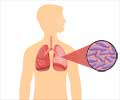Tuberculosis is ravaging Canada's Arctic with infections among Inuit peoples doubling since 2004 and rates now 185 times higher than non-natives, an indigenous group said Wednesday.
Tuberculosis is ravaging Canada's Arctic with infections among Inuit peoples doubling since 2004 and rates now 185 times higher than non-natives, an indigenous group said Wednesday.
And the situation for northern natives who lacked a natural resistance to the disease when it was introduced in the mid-20th century, is worsening, said Gail Turner of the Inuit Tapiriit Kanatami."Behind the high results," she told AFP, "are significant disparities in the health of Inuit and other Canadians and inequity in access to health care.
"It is unconscionable that these conditions exist in a country that boasts of having one of the lowest TB rates in the world," she said.
From 2004 to 2008, some 1,600 tuberculosis cases were diagnosed annually in Canada, which has a total population of almost 34 million, according to the Canadian Tuberculosis Reporting System's latest figures cited by the group.
While the prevalence of the disease has gradually declined in the general population, rates have soared among Canada's 50,000 Inuit from 80.4 to 157.5 during the period. The number of new Inuit cases doubled from 41 to 88.
"Tuberculosis is challenging because there's a perception that it's gone," Turner explained.
Advertisement
Entire extended families can be found cramped into single-room houses. Imported foods are very expensive and locally hunted foods are becoming scarce as disappearing ice cover makes hunting more dangerous.
Advertisement
"In Nunatsiavut, where I live, Inuit must fly to Goose Bay to receive a chest X-ray," she said. "Recently, that meant a group of patients was stranded for 15 days because of weather."
The disease is generally easy to treat, if diagnosed early, but these unique challenges "make it harder to fix," she said.
"It is imperative that a separate strategy be created now for Inuit," she said. "TB will never be eliminated until housing is improved, food security is improved and access to health care for Inuit is closer to what other Canadians take for granted."
Source-AFP










